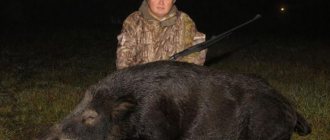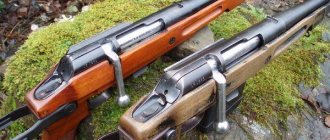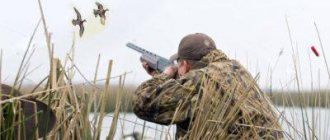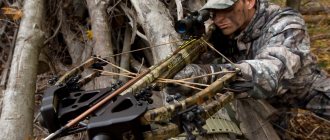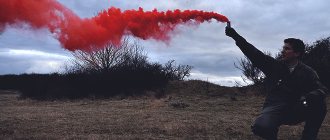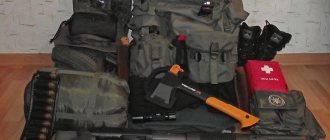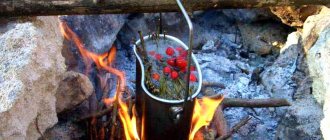Properties of cartridge with container
Gunsmiths have mastered the production of polyethylene containers for cartridges loaded with shot, which perform the additional function of a shutter . They remove powder gas from the barrel channel and the bullet belt. The properties of the wad container do not end there. With it the shooter:
- Increases and improves shooting accuracy.
- During a shot, when the shot leaves the muzzle, the wad prevents deformation.
You can achieve good accuracy by selecting a container in accordance with the parameters of the weapon and cartridge.
They achieve good performance with the technical design of the element:
- Obturator , responsible for the tight connection of the device with the sleeve.
- A shock absorber that holds back the exhaust from the trunks and fills the spaces in them.
- Container – a container for shot.
Such a wad can fail when shooting - it can get stuck in the muzzle . Therefore, hunters often modernize the capsule, cutting off what they think are unnecessary, leaving only the container. Cuts are made in the structure to the very bottom. But these devices can be different in shape, such as:
- Concentrators , which store the shot shell, regulate its separation, provide the desired diameter of the scree with the optimal amount of shot hitting the target.
- Dispersants , they have a cross-shaped rod installed in the middle to ensure an increase in scree diameters, they are used in close-range shooting.
The most common container is one that can protect the projectile from deformation in the bores. In fact, it quickly separates and does not affect the displacement of the center in the expansion relative to the target. Hunters who did not have time to purchase a factory-made plastic container wrap the shot in thick paper or flexible thin plastic.
Cartridges for hunting geese
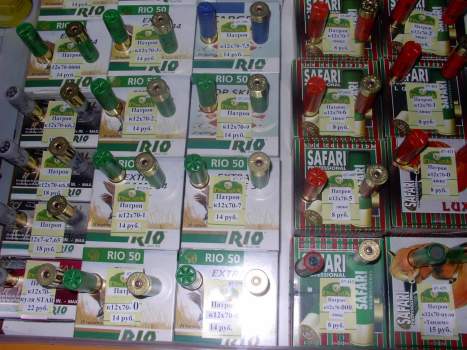
A friend of mine recently tested his ammo on a goose. Fraction No. 0000. The results are as follows: at 35 m in a circle with a diameter of 760 mm - 31 holes, at 50 m - 12, at 70 m - 2 holes, at 100 m - in a circle - none, and in a shield 800 mm by 800 mm - 1 hole. His ardor faded: the results were unimportant. And when hunting a goose, there are a lot of disputes about cartridges. It `s naturally. Getting a goose is not easy. And it flies high, and the speed is high, and it is very careful. Game managers have statistics: out of 100 people, 7-10 goose are killed. There are hunts when shooting with large shot at long and extreme distances is not so rare. First you need to roughly determine the criteria for the distances themselves. I consider the normal distance to be 35-40 m, the long distance - 45-50 m, the maximum - 55-60 m. There are no special questions about shooting at normal distances. For woodcocks this is shot No. 8-7. For small birds (teal, hazel grouse) - No. 6-7. For large ducks - Nos. 6-5, and No. 4. Long-distance shots are more difficult. And the requirements for the quality of the loaded cartridge are increasing. Individual sighting of a specific shot number is required. And the cartridge already needs to be trained for this shot number and at this distance. It is best to pin a black piece of paper with a silhouette of a game onto a target sheet with a diameter of 760 mm. Then, in addition to accuracy (in percentage), sharpness, uniformity, stability, you can also record the number of holes in the body of a hare or mallard. Our hunting publications generally recommend loading cartridges with a container for these distances. The advice is correct, but container is different from container. I have about three dozen types of them. But sometimes choosing the right one is not so easy. Many types produced by various joint stock companies and LLCs are no good. The diameters of the skirts are not consistent, the hems of the cuffs are small, the volume of the container itself is small, the wrong material is taken for manufacturing, etc. As a result, the plan for close-up and sharp long-range combat is not realized. It’s a pity, after all the hassle of preparing for the hunt, to miss a capercaillie, fox, hare or goose. It's better to tinker with loading cartridges for a specific game. We are interested in shots with large shot at maximum distances - 55-60 m (we will not consider successful shots at 70 meters or more, since they sometimes warm the soul only to owners of Magnum shotguns with 76 or 89 mm cartridges). Although I had to deal with this topic too. M.M. also considers this distance to be the maximum. Blum (“Hunting” No. 10, 1997) - for the best gun. And in the “Russian Hunting Newspaper (No. 51, 1997) Yu. Maslov came to the conclusion that at 60 m, accuracy increases better when shooting without a container, but coarse shot, starting from No. 3, consistent throughout the bore, sprinkled with starch. And the wad container gives good accuracy and sharpness at positive temperatures with small shot up to 40 mm. All these conclusions are confirmed by my experiments on shooting with large shot. My opinion is this. If the wad, by its design and quality, is not suitable for this shot, this bore and narrowing, then so be it, i.e. not every wad will increase the firing range. The famous designer from Tula S.M. Sheinin sent me continuous container wads with wings for shooting. Unfortunately, there were no such items for sale. So, by cutting off a couple of wings as desired, you can regulate the beginning of the separation of the container from the shot. The later this happens (with fewer petals), the longer the shot, since the shot is located longer in the container. Well, since they are inaccessible to the majority of hunters, it is better to abandon them if the fight with the container is bad. I am reporting the result of one experiment, probably not known to everyone. In the 60s, gunsmiths, game managers, and fishermen decided to determine what shot and at what maximum distance for coots would be optimal. I emphasize - optimal at the maximum acceptable distance. The conclusion after the experiments was this: 12-gauge gun, barrel length 750 mm, constriction 1.0 mm, shot No. 3. I emphasize that per hundred shots at 60 m, more coots will be caught with shot No. 3 than with shot No. 4 , 5, 2, 1, 0, 00, etc. I believe that we need to find a “golden” mean in choosing a fraction. Of course, the sharpness of Nos. 000, 0000 is higher and you can get a goose when hit at a longer distance, but there is less of it in the projectile and there will be more runaways. Conversely, many heard “slaps” when shot No. 3 hit at the maximum distance. There are such observations by A. Zernov - at 100 meters with a goose area of 300 square meters. cm from a 12-gauge shotgun with shot No. 0000 weighing 32 g (43 pellets), there is one hit with one pellet out of ten shots. Thus, four geese hit by shot will require 36 rounds. Here you should also keep in mind that getting hit means discord. Most likely, out of four hits on one pellet, two will be non-lethal. With such a wound, the goose is dragged far away and the hunter does not get it. This means that for 36 spent cartridges, at best we have two geese. The result, frankly speaking, is unimportant. What fraction numbers should I use? In general, you need to keep in mind that after 35 meters, for every five meters the accuracy drops by 10%. If, for example, the accuracy at 35 m is 75%, then at 70 m it is 5%. Steingold pointed out that shot No. 1 at 60 m is scattered at 2 m, at 70 m - 2.5 m, at 100 m - at 4 m. D. Polyakov (“Hunting and hunting management” No. 12-1980) noted , that the Magnum cartridge reliably hits a duck at a distance of up to 53 m with a shot of 39 g, and quotes the words of Huijs: “Ignorants who shoot further than 50 meters should be ridiculed.” The famous Russian shooter, Colonel of the Tsarist Army E.T. Smirnov wrote: “I always shoot at 40 meters. At 45 meters - good luck with 1/2 to 3/4 shots, at 52 meters I rarely hit, if I hit it, it’s like butter to the heart, I didn’t hit - and so okay, I don’t hit at 72 meters.” The easiest way to match coarse shot is by pushing a felt wad to the choke and pouring shot into the barrel in one layer from above. You will immediately see that only a few fraction numbers will fit tightly and without gaps. If this does not work, you need to select a container. In the USA, Magnum shotguns shoot geese with shot No. 2 at 56 g to 55 m (MOG No. 3, 1995). At 55 m, from a conventional shotgun with shot No. 2, from 1 to 3 pellets hit the goose. We are used to hitting at least 4-5 pellets. Experience shows that two slaughter pellets are enough, namely slaughter pellets. And in order to determine whether they are such, when shooting, you need to place a board under the sheet and navigate by the sharpness of the battle. At least for goose cartridges I take the amount of gunpowder according to the label on the can. My goose cartridge: shot No. 1, 0, 00 (with shot No. 0 in a circle there are 27-30 holes at 60 m). Plastic sleeve, bullet, Sokol gunpowder 2.3g, your own plastic seal. I pay special attention to him. It is necessary to obturate as thoroughly as possible. You can take a Sheinin shot wad for 12 and 16 gauges, then two cardboard spacers, a greased felt wad, 1/3 fiberboard and 36 g shot for MTs21 along with starch (mixed in advance), sealing with an asterisk. Starch - for better shock absorption, a seal - for better sealing, an asterisk so that the cardboard does not interfere with the shot post flying out. A great connoisseur of shotgunning, N.N. Fokin, wrote that sprinkling shot with potato flour is the best concentrator in the world for a choke. So do not neglect this scrupulous work for shooting a goose at a distance of up to 60 m. Let those researchers and hunters forgive me whose experience I did not present in this article. It is important to search and find without sparing ammo, time, and effort. This will come true when hunting. Experience when shooting is the first thing. I know hunters who manage to sneak up on a sitting flock of geese for a sure shot. Why don't they shoot with shot No. 3-1! By the way, you need to practice determining the distance to the target. I define the distance like this: the length of a goose at 60 meters is approximately equal to the width of the muzzle of one barrel with the gun raised. If the silhouette of the goose is much smaller, you can no longer shoot: there are 100 meters or more Anatoly Azarov
Design features of cartridges without containers
The following shotgun shells are used in hunting:
- Smoothbore.
- Rifled.
The charge happens:
- Drobov.
- Buckshot.
- Pulev.
Shotguns are divided according to barrel diameters, the basis for this is the choice of charge by caliber.
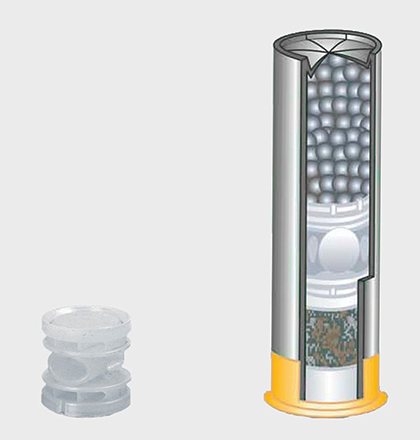
The cartridge consists of elements:
- Sleeves - cardboard, plastic, wood or metal.
- Igniter capsule or piston.
- Projectile from buckshot, shot.
- Wads.
- Powder charge.
Shooting order:
- The firing pin of the gun hits the piston.
- The gunpowder ignites.
- Force is created from accumulated gases.
- The wad pushes the bullet out.
As a result, the charge hits the target. The cartridge is selected by type:
- Gunpowder.
- Shells.
- Fraction number.
The choice of bullets depends entirely on the subject of the hunt. Caliber indicates the strength of the projectile, but not its size.
Shooting in or out
When choosing a shot number for 12-gauge duck cartridges, you should also not forget about exactly how the shooting will be carried out. If you decide to hunt ducks in flight, then you will have to make your own or purchase a cartridge that has low accuracy in order to be sure to hit the target in the air. For individuals that prefer to lead a sedentary lifestyle, the pellets should move towards the aiming point after the shot. A similar figure can be easily achieved by reducing the weight of the ballistic projectile and increasing the amount of gunpowder.
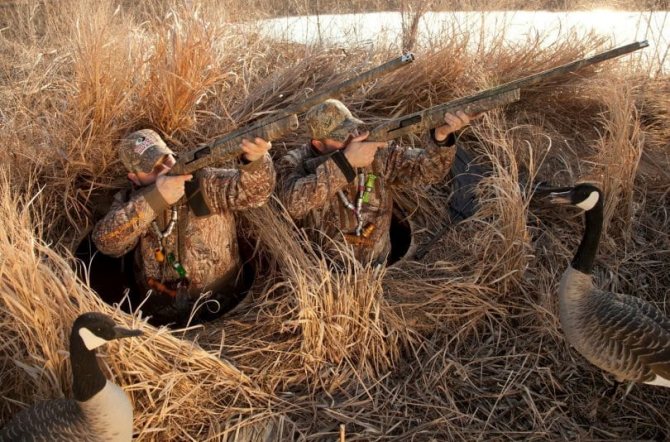
Also, when choosing cartridges in a store, you should take into account the approximate distance from which the shot will be fired, since cartridges with a large shot number have good accuracy at long distances. For shooting from a distance of 20 meters, it is best to use number seven, but for distances from 50 meters, number five is ideal. Also, for hunting from a distance of more than 50 meters, it is necessary to increase not only the number of the shot, but also its canopy in the cartridge, so that the projectile can reach the target while maintaining accuracy.
What parameters in the cartridges are absolutely the same?
First of all, cartridges have one purpose - to hit a target. Same equipment order:
- They take the cartridge case.
- The capsule is inserted.
- Weigh the gunpowder.
- Place a cork or container.
- They fill in the fraction.
- Pressed in.
- Rolled up.
- Labeled.
Some characteristics according to:
- Curves and muzzle pressures.
- Initial speed.
No matter how the theory proves the flight path of the shot with and without a container, photographs of experts show that in both cases its independent flight begins from 3 m from the muzzle .
Autumn
Which duck cartridge should I use in the fall (12 gauge) to shoot game on the fly? Firstly, beginners should avoid using containers, as they will be much more difficult to hit flying prey. Secondly, it is also necessary to take into account the variety of duck:
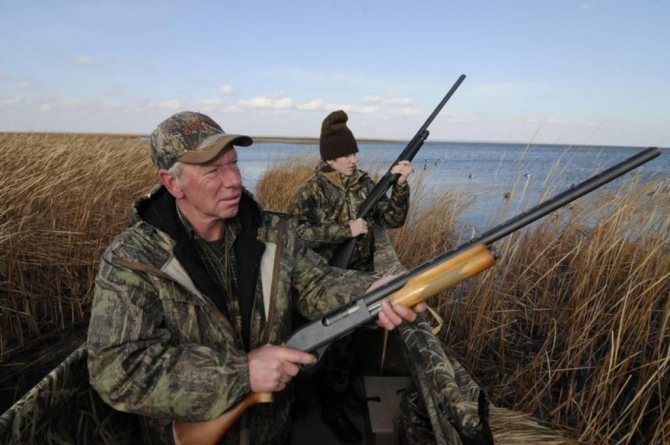
- Shoveler, teal, lutok – No. 5
- red-headed and white-eyed pochard, wigeon, pintail, goldeneye – No. 4;
- gray duck, mallard, shelduck, merganser, scoter, blue scoter – No. 3;
These were the main seasonal factors to consider when choosing shot numbers for duck hunting. Follow these instructions and remember to take into account the distance to the target. The optimal shooting distance is 25-35 meters.
How are the cartridges different?
The first characteristic difference is the placement of shot in a plastic container for shooting accuracy, increased accuracy and the use of independent plugs.
In containerless charges, gaskets made of the following material are used:
- Felt.
- Cork.
- Wood fiber.
- Plastic.
- Woolen.
- Leather.
What else is different about a cartridge without a container:
- Powder gases break through the plugs, reducing accuracy and combat sharpness.
- Less fractional uniformity after leaving the muzzle.
- The quality of the shot is worse at long distances.
- More impact.
The invention of the container greatly simplified the procedure with equipment.
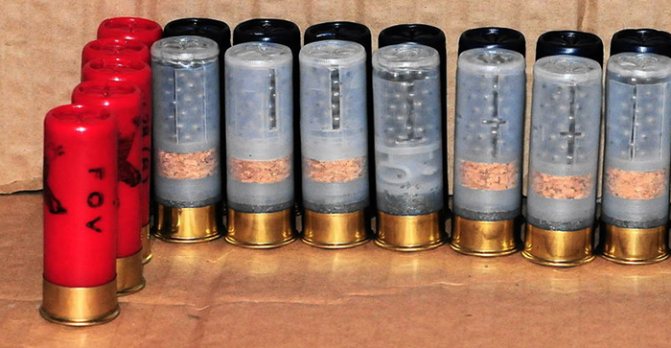
Black powder
It should be borne in mind that when choosing which gunpowder is best for 12 gauge, you can come across many manufacturers of this product. But most are still less common than the 3 leaders presented here. Therefore, their product is often considered the best gunpowder for 12 gauge.
Black powder deserves special attention. The powder weight for 12 gauge is presented in the table. The values are indicated for positive air temperatures.
| In 12 gauge cartridges | 5-5.8 g |
| 16 gauge | 4.5–5.3 g |
| 20 gauge | 3.7–4.8 g |
| 28 gauge | 2.7–3.4 g |
The shot is taken in the same mass as for the Falcon.
If shooting is carried out at temperatures below 0, then the mass of gunpowder is increased by 1-1.2 g. If bullet cartridges are loaded, its weight is increased by 5%.
It must be remembered that the smaller the black powder, the more powerful it is. For this reason, the required amount is chosen empirically. If the gunpowder is damp, you need to get rid of it. If you dry it out, it still won't be effective.
Thus, it is not enough to choose which gunpowder is best for 12 gauge. It is necessary to take into account the shooting targets and the characteristics of each brand. Each variety can be used as efficiently as possible in accordance with your goals.
Ammo loadout options
The first most common option is the following combination. Add 2 cardboard wads of 1.5 ml to cartridge cases with Zhevelo primers and Sokol gunpowder. In the old way they are called gaskets. Next, a greasy felt wad is placed above them, on which, if necessary, a non-greased felt wad is placed. Then lay out the shot with a cardboard lining made of loose material, rolling the barrel of the cartridge case. The best equipment option is a 2.25 g gunpowder charge. Based on your goals, you can choose the required type of gunpowder. It must be remembered that when choosing a sample, the manufacturer of the substance is always taken into account. After all, the characteristics of gunpowder will vary depending on its brand and batch.
This option is considered the second most popular option for equipping a cartridge. The same procedures are performed as in the first case, but 2 cardboard gaskets are replaced with one polyethylene seal with a small hole in the center. The best shooting quality was noted with a powder charge weight of 2.15 g, if we were talking about the Falcon.
There is a third type of charge. In it, 1 1.5 mm thick cardboard spacer is placed on a polyethylene seal. A felt wad is already placed on top. The best result in weapon combat was achieved by a combination with a gunpowder weight of 2.05 g. The shot is used in the same quantity, but there is a significant saving in the matter of gunpowder.
In the fourth option, polyethylene seals without any holes are laid on the gunpowder, and then a greased felt wad and all other components are placed, as in the combinations listed above. The best option is considered to be a mass of 2.05 g of gunpowder. The results are identical to the third way.
The fifth option is done like this. A polyethylene wad with a shot concentrator is placed on the gunpowder. Then repeat the previous option. The best results were observed with a powder weight of 2.05 g.
In the sixth option, take a wood-fiber wad and place it on 2 cardboard wads, the total thickness of which becomes 3 mm. The best result in shooting was a gunpowder weight of 2.35 g.
Legal restrictions
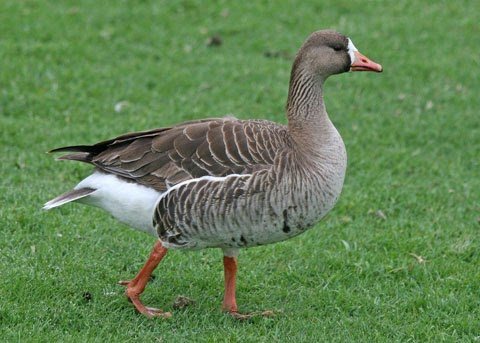
White-fronted goose
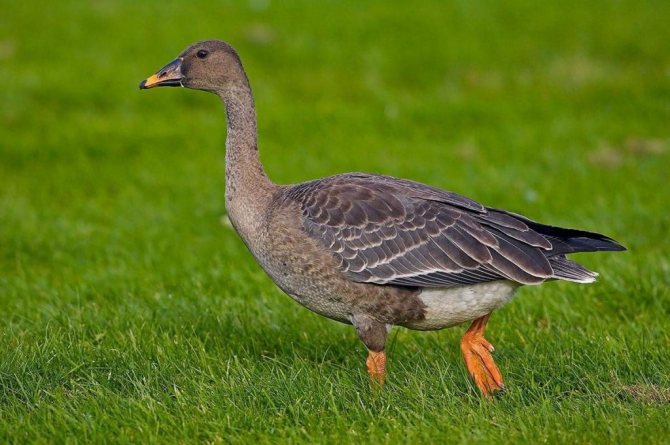
Gooseberry
In spring, you can only hunt male white-fronted goose and bean goose; hunting from the approach and using watercraft is prohibited. Read more about hunting rules in our article.
In addition, in some regions, spring goose hunting is generally prohibited or limited by quotas; read more about the timing of the opening of hunting in your region here.

